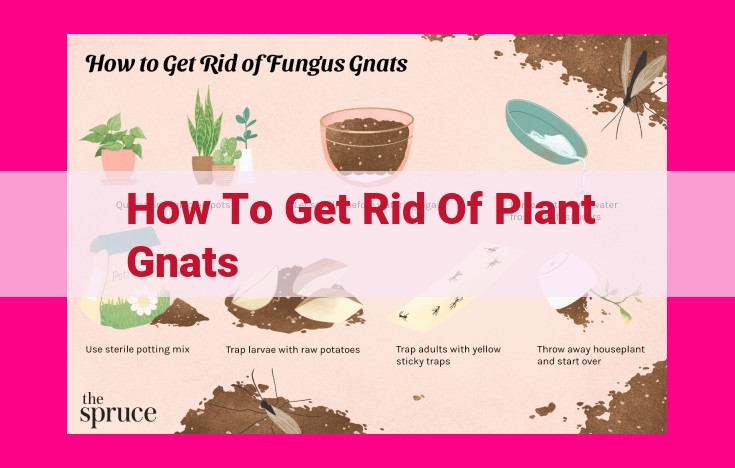Comprehensive Fungus Gnat Control: Biological, Physical, Chemical, And Microbial Solutions

To eliminate fungus gnats, consider using beneficial insects or nematodes to control them biologically. Incorporate physical measures like diatomaceous earth and regulating watering to create an unfavorable environment. For chemical control, apply neem oil, tea tree oil, or hydrogen peroxide to target gnats and larvae. Beneficial microbes can also be utilized. Remember to approach fungus gnat control comprehensively by combining multiple methods for optimal effectiveness.
The Problem of Fungus Gnats: A Common Threat to Indoor Plants
Fungus gnats are tiny, yet persistent pests that can wreak havoc on indoor plants. Their presence not only detracts from the aesthetic appeal of your greenery but also poses a threat to their health. These small flies are attracted to moist soil, making them a common problem in overwatered plants. They lay their eggs in the soil, and the larvae that hatch feed on the roots and decaying organic matter.
The negative impact of fungus gnats on plants can be significant. They can hinder root development, stunt growth, and even cause wilting or yellowing of leaves. In severe infestations, plants can become weakened and susceptible to other pests and diseases. Moreover, fungus gnats can spread fungal spores, contributing to the development of mold and other plant pathogens.
Understanding the commonality and potential consequences of fungus gnats is essential for plant owners to develop effective control strategies. By taking proactive measures to combat these pests, you can protect your plants and maintain a healthy and thriving indoor environment.
Biological Control: Nature’s Allies in Fungus Gnat Battle
Introduction:
Fungus gnats, tiny yet pesky pests, plague plant enthusiasts, causing stunted growth and yellowing leaves. But fear not; nature has our backs with a battalion of biological allies ready to wage war on these invaders.
Beneficial Insects: Tiny Warriors
Ladybugs, lacewings, and predatory mites are valiant insects that devour fungus gnat larvae and eggs. Introduce them into your indoor garden to create a natural insect patrol.
Mighty Nematodes: Microscopic Guardians
These microscopic worms are the underground army fighting fungus gnats. They penetrate larvae, releasing bacteria that lead to their demise. Steinernema feltiae and Heterorhabditis bacteriphora are two effective nematode species to consider.
How to Use Beneficials
To unleash these natural warriors, purchase them from reputable suppliers and release them in your plant’s soil. Follow the instructions carefully, as each species may have specific requirements. Monitor your plants regularly to observe the effectiveness of the biological control.
Benefits of Biological Control
* Chemical-free pest management: Avoid harsh chemicals that can harm plants and beneficial insects.
* Long-term solution: Beneficials establish themselves in the soil, providing ongoing pest suppression.
* Improves soil health: Nematodes contribute to soil aeration and nutrient cycling.
Conclusion:
Harnessing the power of beneficial insects and nematodes is a sustainable and effective way to combat fungus gnats. By introducing these natural allies into your indoor garden, you’ll create a thriving ecosystem where plants flourish and pests are kept at bay.
Physical and Cultural Control: Creating an Unfavorable Environment for Fungus Gnats
In the realm of pest management, fungus gnats can be a pesky foe, wreaking havoc on your precious plants. But fear not, for a plethora of physical and cultural techniques exist to create an environment that these tiny insects find unwelcoming.
Diatomaceous Earth: A Microscopic Death Trap
Diatomaceous earth, the fossilized remains of tiny algae, works as a natural insecticide. Its sharp edges shred the exoskeletons of fungus gnats, leading to their watery demise. Sprinkle this powdery wonder around the base of plants and on the soil’s surface to deter these unwanted visitors.
Regulating Watering: The Art of Moisture Control
Overwatering is a banquet for fungus gnats, providing a moist breeding ground for their young. Water plants only when the soil feels dry to the touch. This simple adjustment will make your plants less attractive to these pests, as they crave soggy conditions.
Removing Organic Matter: Depriving the Enemy
Decaying leaves, dead roots, and other organic matter are magnets for fungus gnats, providing them with food and shelter. Regularly remove these debris from your plants and pots to reduce the population of these unwanted guests.
By implementing these physical and cultural control measures, you can transform your gardening space into an unfavorable haven for fungus gnats. Remember, prevention is key, and these techniques will help you maintain a healthy balance in your plant kingdom.
Chemical Control: Targeting Insects and Pathogens
When it comes to combating fungus gnats, chemical control offers a targeted approach against these pests. While biological and physical methods aim to create an unfavorable environment, chemical treatments eliminate the insects and their larvae directly. Here are some effective chemical options:
Neem Oil: Derived from the neem tree, this natural insecticide contains compounds that disrupt the growth and development of fungus gnats. It acts as a repellent and can effectively control both adult flies and larvae.
Tea Tree Oil: Another natural insecticide, tea tree oil exhibits antifungal and antimicrobial properties. It targets the fungus gnats’ larvae and helps prevent the spread of the infestation.
Hydrogen Peroxide: This mild acid can kill fungus gnat larvae that infest potting mix. It releases oxygen upon contact, creating a hostile environment for the insects.
Beneficial Microbes: Certain bacteria and fungi can be introduced into the soil to establish a balance against fungus gnats. These beneficial microorganisms compete for resources and release compounds that are harmful to the pests.